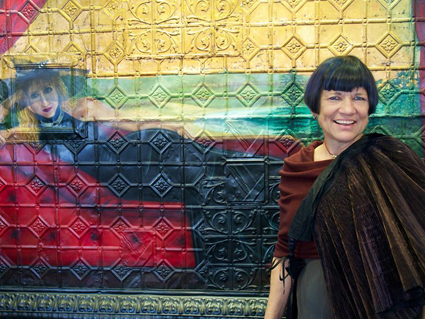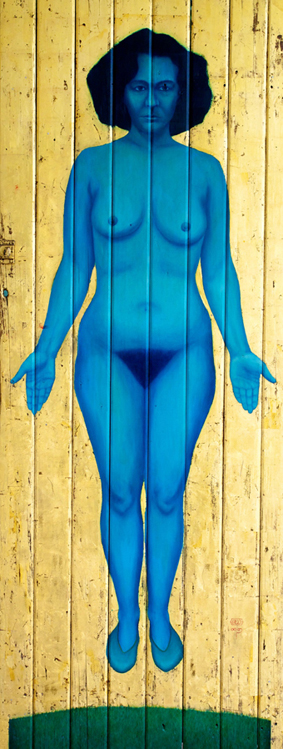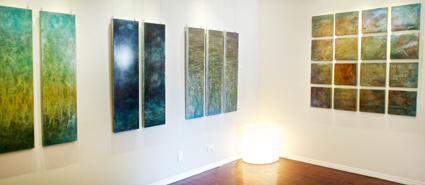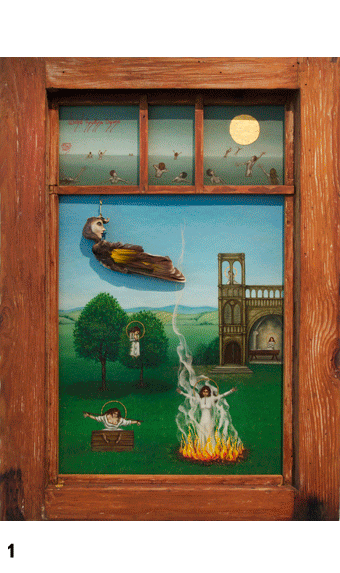In profile: AñA Wojak, 3 Decades
Jeanti St Clair

Aña Wojak with Odalisque with Fascinator (1995); 3 Decades
photo David Corazza, courtesy the artist and The Channon Gallery
Aña Wojak with Odalisque with Fascinator (1995); 3 Decades
Artist’s Statement
How to write 250 words about 30 years of art practice: painting, performance, installation, assemblage and theatre design?
This diversity is akin to being multilingual, having different languages in which to express myself, each having words and expressions unique to itself. Yet, there are also always common words, links, expressions that cross over between those languages.
An exhibition of paintings is just an ephemeral site-specific installation comprising images in a room. So, with each successive suite I have made a point of emphasising this aspect of the work.
Although earlier paintings clearly display the Eastern European pre-Renaissance influences, the later work, focussing purely on the abstract quality of light, maintains continuity, being painted with the same technique of transparent glazes on metal.
Painting on salvaged metal and found objects adds another layer to the vocabulary. I am not dealing with tabula rasa, rather a dialogue with the complex histories and textures each found object or surface brings to the conversation, site specificity being an important element in my work.
Ritual has also played a role: the fetish of objects and actions, imbuing them with power and significance. This is manifest in the mythologised subjects of the painted works, through the intimacy of assemblages, the power of suggestion with scents in large-scale installations, the repetition, rhythms and visceral pain of durational performance…
Which brings me back to the act of painting, which is in itself a durational performance for an unseen audience.
AñA Wojak
http://www.anawojak.com

Aña Wojak, Divine Madonna (1988), 3 Decades
photo David Corazza, courtesy the artist and The Channon Gallery
Aña Wojak, Divine Madonna (1988), 3 Decades
A fleeting 30 years
In this survey of three decades of AñA Wojak’s paintings, it is clear the cross-disciplinary artist has a close but evanescent relationship with her art.
Each painting has a story, history and purpose and the works explore Wojak’s favoured inspirations: her Eastern European heritage and its religious iconography, eroticism and the environment she lives in. She approaches the gathering of art materials like a bowerbird, working on recycled wood, pressed tin and industrial steel sheet. She has a penchant for gold leaf, found objects and lustrous oils. Creation is an active meditation and the exhibition is a careful, deliberate installation and performance of her art. She’s connected to all her works, but attached to none.
To grasp her philosophy of ephemerality, I asked Wojak to walk me through her exhibition. She strode immediately to her abstracts from past decade: works from the four exhibitions from the Chatoyant series (2001-2009). These exhibitions (Standing on an Island, lightboxes, LATITUDE and 4 quarters) were both site installations and painting exhibitions.
Chatoyant, which means to have a changeable or undulating lustre, marked a shift for Wojak from working figuratively and in landscape on pressed tin to working with recycled steel sheets. She burnishes the steel with industrial wire brushes and applies translucent, subtle layers of oil paint to create light-reflecting textures, inspired by early Renaissance techniques. The result is more modern, producing an impressionistic and evocative shimmering, a Monet without the lilies.

Aña Wojak, East (2009) & Lightboxes – Genesis (2005); 3 Decades
photo David Corazza, courtesy the artist and The Channon Gallery
Aña Wojak, East (2009) & Lightboxes – Genesis (2005); 3 Decades
Wojak described how 2005’s lightboxes exhibition at Sydney’s Depot Gallery reflects her work’s ephemerality. Originally, the 80 panels (30cm x 30cm) were arranged in a 16×8 grid to create an overall flow, yet all were for sale as individual works. Wojak encouraged people to buy singles, or blocks or strips of panels. Once sold and dispersed, the grid could never exist again.
In 3 Decades, lightboxes make fleeting appearances as singles, pairs, strips and blocks around the gallery. A standout is the golden Genesis, a set of 16 squares of flashing luminescence in a re-imagined configuration that came together after the lightboxes exhibition was dismantled. This was Wojak’s 2003 Blake Prize for Religious Art entry. (She would win the prize in 2004 with pieta, darfur). A trio of works from 2007’s LATITUDE hang together, offering an intimation of the powerful original configuration of 52 steel panels, graduating in colour and size and united by a horizontal band of light through each centre.
This horizontal line has connections with Wojak’s earlier landscape paintings. The sunset horizon, the kiss between day and night, in WEST ONE is one example of the site-specificity and durational aspects of her art practice playing out. She captures a sunset’s fleeting intensity, drawing the eye to a thin horizon line of gold leaf, dividing rust red from deep twilight blue. The faded lettering on the derelict tin Weston Butter sign clues her direction to the sunset, while the corroded texture influences the painting’s narrative.
While that application of gold leaf is subtle, in many of Wojak’s figurative works from the 1980s and 1990s, it was a dominant compositional tool. Divine Madonna (1988), an electric Krishna blue standing nude woman, levitates above a soft green mound. Painted in pure manganese blue, she is otherworldly, pre-Renaissance against the shimmering gold, but pockmarked dunny door she is painted on. In the Odalisque series, with its attention on eroticism and performance, gold leaf appears as a light source, highlighting both the figurative poses and the decorative fleur de lys patterns and stippled surfaces of the pressed tin ceiling panels she employed from the 1990s.
However, 3 Decades is incomplete as a survey exhibition, as Wojak’s art practice has incorporated performance since the mid 1990s, and this has been a particularly productive stream of activity in the past four years. Wojak’s performative installation exploring her family’s migration from Poland, stepping stones…, exhibited at Lismore Regional Gallery in April 2014, demonstrates the integration of transience of time and of place as the uniting theme of her art practice.

Aña Wojak, 1) St Christina the Amazing; 2) St John the Baptist; 3) St Paul the Hermit; 4) St Simeon Stylites, (1983); 3 Decades
photo David Corazza, courtesy the artist and The Channon Gallery
Aña Wojak, 1) St Christina the Amazing; 2) St John the Baptist; 3) St Paul the Hermit; 4) St Simeon Stylites, (1983); 3 Decades
But Wojak often brings the performative alive in the subject matter of her paintings. You can see this in the Odalisque series and in her earliest works in 3 Decades, the mixed-media portraits of eight Christian saints which she painted in the early 1980s for her Masters degree in Gdansk, Poland. Wojak speaks warmly of these works and their materials, as they represent an extended period of keen focus, and years spent studying in her family’s homeland.
She depicts the hermit-saints’ miracles as Gothic narratives but in a naïve style, using the colours of a children’s Golden Book. Around each tableau, an old window or cupboard doorframe invite us to look in and become witnesses to the unfolding miracles. And then, suspended, as if on a stage, is each saint represented as a puppet. Created from objects found around Gdansk, the puppets are like dancing relics. The St John the Baptist puppet is made from plant stems and a dried mouse body, his head a tiny clay sculpture. The puppet of St Christina the Amazing, whose miracle was to rise from the dead and levitate, is part bird’s wing.
It seems unfortunate these curious, quirky saints are for sale individually, that this collection of early works will be split up. But, AñA Wojak says, one found a home years ago in Sydney and she is happy for them to go to new owners. One now sells at the exhibition opening. Everything, after all, is ephemeral.
AñA Wojak, 3 Decades, The Channon Gallery, Channon, NSW, 11 May-8 June; http://www.thechannongallery.com
Jeanti St Clair lectures in journalism and radio production at Southern Cross University in Lismore, NSW, and is the arts critic for ABC Radio North Coast.
RealTime issue #120 April-May 2014 pg. web






